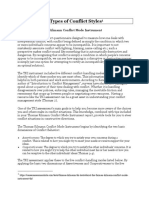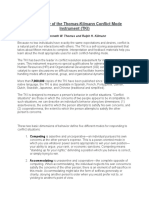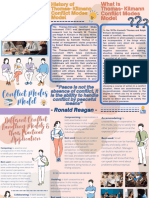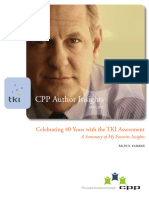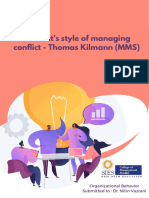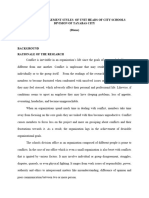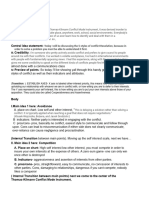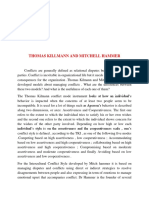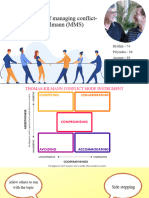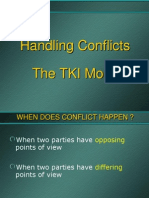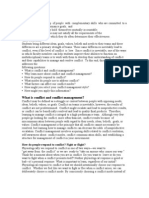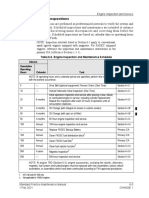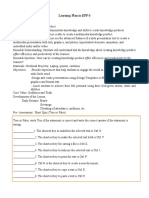Understanding Conflict Resolution with the Thomas-
Kilmann Method
Introduction:
Conflict is an inevitable part of human interaction. Whether it's in personal relationships, the workplace,
or global politics, conflicts can arise due to differing perspectives, values, or goals. While conflict itself is
natural, how we manage and resolve it can make all the difference in the outcome. The Thomas-Kilmann
Conflict Mode Instrument (TKI) is a valuable tool for understanding and effectively addressing conflicts.
In this blog, we'll explore the Thomas-Kilmann method of resolving conflicts and how it can help
individuals and organizations navigate disputes more productively.
The Thomas-Kilmann Conflict Mode Instrument
Developed by Kenneth W. Thomas and Ralph H. Kilmann in the early 1970s, the Thomas-Kilmann Conflict
Mode Instrument (TKI) is a widely used framework for analyzing and resolving conflicts. This model is
based on two fundamental dimensions of conflict behavior:
Assertiveness: This dimension represents the extent to which an individual seeks to satisfy their own
needs, concerns, or goals. High assertiveness indicates a person's focus on self, while low assertiveness
reflects a preference for accommodating others.
�Cooperativeness: Cooperativeness measures the degree to which an individual is willing to collaborate
and address the needs and concerns of others. High cooperativeness reflects a willingness to
compromise, while low cooperativeness signifies a competitive or unyielding approach.
The TKI model organizes these two dimensions into five distinct conflict-handling modes:
Competing (High Assertiveness, Low Cooperativeness): This mode involves pursuing one's interests
aggressively and often comes at the expense of the other party's interests. It's appropriate when quick,
decisive action is necessary, such as in emergencies.
Collaborating (High Assertiveness, High Cooperativeness): Collaboration seeks a win-win outcome by
addressing the concerns and interests of all parties involved. This mode is useful when complex issues
require multiple perspectives and creativity.
Compromising (Moderate Assertiveness, Moderate Cooperativeness): Compromise entails finding middle
ground by giving up some individual needs to meet the needs of others. It's useful in situations where a
temporary solution is required, or when consensus isn't possible.
Avoiding (Low Assertiveness, Low Cooperativeness): Avoidance is characterized by sidestepping conflicts
altogether or delaying resolution. It may be appropriate when issues are minor or when emotions need
time to cool off.
Accommodating (Low Assertiveness, High Cooperativeness): Accommodating involves giving in to the
needs and concerns of others while neglecting one's own. It's suitable when maintaining relationships is
a higher priority than achieving personal goals.
Applications of the TKI Method
The Thomas-Kilmann Conflict Mode Instrument offers several valuable applications:
Conflict Resolution: Individuals can use the TKI to assess their natural conflict-handling style and develop
the ability to adapt to different situations. This helps in resolving conflicts more effectively, whether in
personal relationships or professional settings.
�Team Dynamics: Teams benefit from understanding the diverse conflict-handling preferences of their
members. Leaders can create balanced teams by considering these preferences and ensuring that all
modes are represented, thus fostering more well-rounded decision-making and problem-solving.
Organizational Development: Companies can use the TKI to improve conflict management within their
organization. It can guide training programs, help define the company's conflict resolution culture, and
lead to more harmonious workplaces.
Negotiation: Negotiators can employ the TKI to assess their own and their counterpart's preferred
conflict-handling styles, allowing them to tailor their approach for more productive negotiations.
Conclusion
The Thomas-Kilmann Conflict Mode Instrument is a valuable framework for understanding and resolving
conflicts in various life situations. By identifying and adapting conflict-handling styles, individuals and
organizations can work toward more constructive resolutions, better relationships, and improved
decision-making. Remember that no single conflict-handling mode is always appropriate; the key is to
apply the right approach in a given situation to achieve the best possible outcome for all parties
involved. The TKI method, with its emphasis on assertiveness and cooperativeness, provides a flexible
and comprehensive tool for navigating the complex landscape of human conflict.

